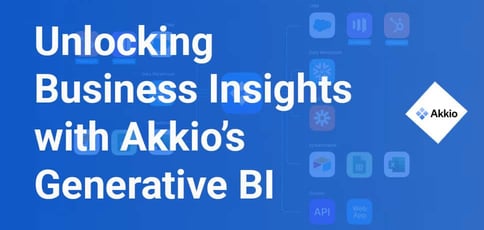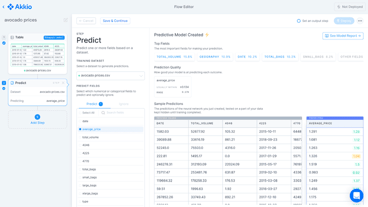
TL; DR: Akkio is a generative business intelligence (BI) solution that empowers business analysts to interact with their data effortlessly, build generative visualizations, and create machine learning predictive models. The platform integrates with various apps and helps businesses with lead scoring, revenue forecasting, and customer insights. We chatted with Chief Operating Officer Jonathon Reilly to dive deeper into how Akkio works, what it offers, and how it can make business analysis more seamless than ever.
In a world where data reigns supreme, knowing how your business performs is the best way to fast-track success. Yes, success is subjective, but no matter how you measure it, analytics can show hidden insights that businesses may not realize they can use.
For example, you can analyze the booking data if you want to know the most popular day to book clients at your hair salon. Or, if you’re a project manager for an IT team and want to optimize your team’s productivity, you can plug in some metrics and identify areas where they excel and areas that need improvement.

The thing is, performing analyses isn’t a walk in the park: They’re expensive, time-consuming, and require the right tools. But that’s where Akkio comes in.
“A lot about Akkio is the ability to take complex things like data science and make it really easy to use,” said Jonathon Reilly, Chief Operating Officer of Akkio. “A lot of it is taking large language models and enabling people to extract insights without knowing how to write SQL queries, complicated code, or make graphs in Excel.”
In short, business owners and analysts enter a new era of productivity with Akkio’s approach to simplifying data science with generative business intelligence (BI).
Empowering Business Analysts with Generative BI
Whether you’re a business analyst or have one on your team, it’s a vital role to occupy. Analysts are the ones who will offer opportunities for improvement and sound the alarm if there are budget restraints in a project. But, as you might guess, the job can be extremely time-consuming, especially with larger teams and projects.
Akkio is a generative business intelligence solution that empowers users to interact with their data in ways they couldn’t have before. With Akkio, you can easily chat with your data and give it commands (like “remove these outliers”), build generative visualizations from any set of data, and create your machine learning (ML) predictive models (such as sales forecasting).
Akkio is the one-stop solution for businesses on a budget who still want to gain valuable insights. The platform can be used for any business operations, ranging from marketing, sales, finance, customer support, and human resources. It integrates with Hubspot, Snowflake, Big Query, Salesforce, Google Sheets, and Zapier, with more apps on the horizon.
“Akkio is perfect for small to medium businesses that don’t have a large, dedicated data science and analytics team — but still have data and problems they want to solve,” said Jonathon.
But Akkio wasn’t always this smooth generative AI software. Like most everything else, it started from a small idea after a group realized there was a problem and no easy solution.
“We come from a long history of working in startups and big companies, but our experience is that it’s hard for people who work in operations to extract the most value from their data,” said Jonathon. “We noticed it’s a complicated task with so much data wrangling that it feels like exploratory data analysis.”
So Akkio’s mission statement came to life: “to democratize data science and enable a new generation of AI-powered businesses.” In other words, Akkio aims to make business data easy to understand and analyze without the unnecessarily huge learning curve.
Does Your Business Need BI?
Business intelligence (BI) sounds like artificial intelligence. They’re related — in a sense. They’re both pivotal in making informed decisions or shedding light on new information.
But AI is all about interacting with a human end-user in plain language by learning from data and making decisions based on its training. In contrast, BI is a set of processes and tools that helps businesses analyze data so it’s broken down into understandable and actionable meaning. BI answers the question, “What happened and why did it happen?”
Businesses may use BI for several reasons, including:
- Data analysis and reporting
- Decision-making
- Identifying trends
- Performance monitoring
- Compliance/risk management
- Data visualization
- Forecasting
- Customer insights
Jonathan explained that Akkio is about getting to your answer without a huge learning curve. “We allow you to use natural language to explore your data, which means you can ask a question of any live data set you have, and Akkio will generate an answer or chart,” he continued.
The BI tool can forecast revenue, analyze performance metrics, predict market trends, and even offer insight into risk management and customer satisfaction rates.

Despite these capabilities, Jonathon and the Akkio team know that BI still grapples with its own set of challenges. “The main problem with large language models is that they can just make stuff up,” said Jonathon.
This phenomenon is called “hallucinating” and is when the AI model predicts the most probable answers. As a result, the AI may offer incorrect responses. Akkio takes precautions to ensure the AI predictions are based on general patterns learned during training and not on specific details from your data.
“Instead, we use them to write the code to extract the answer from your dataset,” Jonathon explained. “Our approach, along with providing an AI interpretation, eliminates the chances of the AI making things up or giving wrong answers based on the users’ data, which can create biases.”
What’s Next for Akkio
Up next on Akkio’s docket is scenario modeling. The operations team is interested in exploring how its model can analyze different what-if scenarios and how modifying certain variables can affect the desired outcome.
“Once you understand what’s driving your outcomes, the next question you might have is, ‘What happens if I change something?’” said Jonathon. “How will your outcome look different then?”

Say you want to improve customer retention rates for your contract software development company. With Akkio, you use a model that predicts the likelihood of a customer not renewing their contract based on various factors, including project success scores, customer satisfaction reviews, and response times.
You want to determine how modifying certain variables can impact customer retention. Akkio’s new feature can allow you to model different scenarios to see what works in improving customer loyalty. For example, if you offer incentives for long-term contracts, how many of your clients opt to renew on the spot? Information like this can be the difference between stagnant sales and sustainable growth.
Scenario modeling is still in the works, but there’s no doubt it’s another crucial step to simplifying data analysis. After all, Jonathon put it best: “For a long time, working with data has been a scary proposition with a large learning curve that required some sophistication and education. But with the use of AI tools, that’s all changing.”
Check out Akkio today, or try it first with a free demo or trial.



